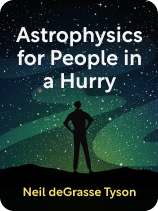

This article is an excerpt from the Shortform book guide to "Astrophysics for People in a Hurry" by Neil de Grasse Tyson. Shortform has the world's best summaries and analyses of books you should be reading.
Like this article? Sign up for a free trial here.
What’s dark matter? Could it be undiscovered black holes or even planets?
We can’t see wind, but we know it’s there because of its effects on things we can see. That’s how it is with dark matter. In 1937, astronomers observed galaxies moving around as a result of a huge mass they couldn’t see. This “missing mass” problem gave rise to the concept of dark matter.
According to Neil deGrasse Tyson, dark matter is a mystery that raises fascinating questions. Continue reading to learn what dark matter is not and what it might be.
Dark Matter & Missing Mass
In addition to expanding what we know about the universe, our deep space observations also reveal that there are major gaps in our understanding of the cosmos. According to Neil deGrasse Tyson, dark matter is one of these problems.
There appears to be far more gravity in the universe than all the matter we observe can account for. Dark matter’s effects have been known for nearly a century. But, to date, we can tell only what it is not, though our observations of the early universe give some tantalizing clues.
| A Primer on Gravity To understand the problem dark matter poses, it’s important to know the basics of gravity. It was first defined by Isaac Newton as the force by which any two objects with mass attract each other. For instance, just as Earth’s gravity exerts a pull on the mass of your body, your body also exerts a pull on the Earth. Newton couldn’t explain how this force works between objects that aren’t touching each other, such as the Earth and its moon, but he formulated a law that predicted exactly how much force objects exert on each other. The next breakthrough was made by Albert Einstein, who was able to solve the problem Newton couldn’t. Einstein proposed that objects with mass bend space and time around them, and that gravitational attraction is the observable effect of the “dent” that objects with mass make in space. Einstein’s theory made several predictions that wouldn’t hold true under Newton’s theory, such as that gravity bends rays of light or that cataclysmic stellar events might create gravitational waves, as observed in 2015. However, because of dark matter, the light from distant galaxies is bent more than it would be by the visible objects in its path. |
The discrepancy between gravity and observable mass isn’t trivial. Tyson asserts that Einstein’s expansion of Newton’s gravity equation has passed every practical and experimental test, yet 85% of the gravitational attraction we measure on the cosmic scale seems to come from invisible sources. This “missing mass” problem was first discovered in 1937 when astronomers plotting the motion of galaxies in clusters found them moving as if acted upon by a giant mass that wasn’t there. Since then, the same observations have been made even within individual galaxies.
(Shortform note: Unfortunately, it’s hard to put a galaxy on a scale to weigh it. Astronomers measure the mass of a galaxy by observing the motion of smaller galaxies and stars that orbit it. Using this method, we’ve been able to compute that our own Milky Way galaxy is 1-2 trillion times as massive as our sun. However, according to our best estimates, there are “only” about 200 billion stars in the Milky way, the majority of which are smaller than our sun, leaving 90% of the galaxy’s mass unaccounted for.)
To be clear, we don’t know what dark matter is, or even if it’s a form of matter at all. The name “dark matter” is merely a placeholder for something we know is there only because of its effects on what we see. It’s not a bunch of undiscovered black holes; we’d be able to detect them via x-ray emissions. It isn’t massive dark clouds in space; we’d see them blocking the light from behind them. It can’t be planets or asteroids; they’d have to take up six times more mass than stars, which Tyson says is exceedingly unlikely. What’s most confusing is that we observe dark matter’s effects only on the largest scale, not on the motion of stars and planets. None of our space probes have ever gone off course because of the pull of a dark matter object.
(Shortform note: It may not be true for much longer that dark matter’s effects can’t be observed within the solar system. NASA scientist Jim Green and mathematician Edward Belbruno have calculated that the probes we’ve sent the farthest into space, such as Voyagers 1 and 2, may have been pulled minutely off course by the presence of dark matter in the solar system. They propose that a probe with highly sensitive equipment may be able to measure this divergence if sent out to 100 times the distance from the Earth to the sun.)
According to Tyson, our observations of the early universe give us some insight into the dark matter problem. We know that dark matter doesn’t fuse with hydrogen and helium—if it did, the proportion of those elements would be different from what we observe. However, it could be that dark matter is responsible for the “lumpy” nature of the early universe. If so, without dark matter’s gravitational influence, the stars and galaxies may never have formed. Our best guess is that dark matter consists of an undiscovered type of particle that interacts with others via only gravity, ignoring the other three fundamental forces. Whatever it is, dark matter’s effects show that the so-called “normal” matter we know is only the tip of the universal iceberg.
(Shortform note: In the absence of direct observation, scientists create mathematical models to predict the hypothetical effects of dark matter, which astronomers can then search for in the universe. For example, one such model proposed that dark matter particles created in the Big Bang may have had an equivalent mass to protons and neutrons. However, the same model shows that the small dark matter particles would have interfered with the formation of light elements, such as hydrogen and helium. Models that predict a different universe than we actually observe are unlikely to be accepted as viable theories.)

———End of Preview———
Like what you just read? Read the rest of the world's best book summary and analysis of Neil de Grasse Tyson's "Astrophysics for People in a Hurry" at Shortform.
Here's what you'll find in our full Astrophysics for People in a Hurry summary:
- Neil deGrasse Tyson's simple explanations of some of the mysteries of the cosmos
- Why everyone should understand where we fit in the universal scheme
- Why humans need to climb off their pedestals






